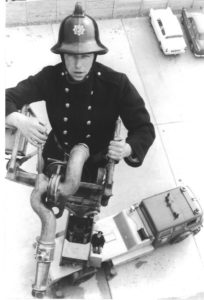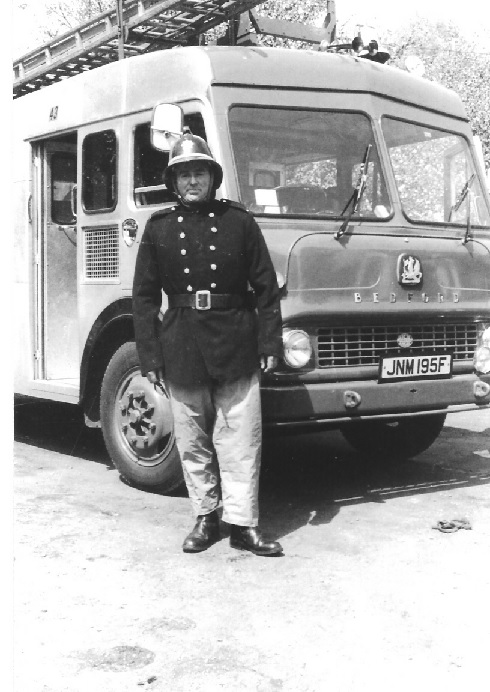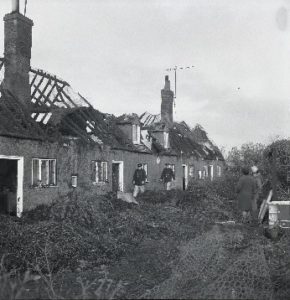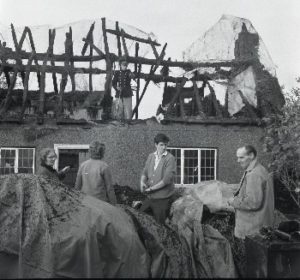Kempston Mill
Saturday – Sunday 17th -18th May 1969
I had not joined the fire service at the time of this incident at Kempston Mill; I was busy at the hospital and engaged in my hobby of photography. For interest and as I attended this fire I thought it best to include in this my story. Sub Officer Chum Lazenby had been kind enough to grant permission for me to stay overnight on station at Barkers Lane on Saturday the 17th May 1969 My father in law Joe Housden loaned me his car overnight so that in the event of a call I would be able to follow the appliance to its destination, and hopefully bag a few good photographs. It was a very quiet evening at the fire station; I joined the watch at 1800 and spent the evening on a learning tour and photographing most of the activities that were of interest. The watch were very helpful in every way.

Above: Fm. Burridge at the top of the turntable ladder, taken during a drill session. 17th May 1969
Photograph: Author
 At around 2230 we all turned in to bed I slept in the dormitory with the duty watch and had a good nights sleep, then woken at 0730 with a cup of tea there had been no calls during the night. After washing and taking up the bedding it was time for breakfast at about 0730, and a good breakfast it was. As I walked around the station taking the odd photograph I was a little disappointed that we had received no calls at all and at 0900 I would be returning home with no story or a photograph. At 0826 Britannia Road Fire Control received the first of several calls to “Kempston Mill King William Road Kempston”.
At around 2230 we all turned in to bed I slept in the dormitory with the duty watch and had a good nights sleep, then woken at 0730 with a cup of tea there had been no calls during the night. After washing and taking up the bedding it was time for breakfast at about 0730, and a good breakfast it was. As I walked around the station taking the odd photograph I was a little disappointed that we had received no calls at all and at 0900 I would be returning home with no story or a photograph. At 0826 Britannia Road Fire Control received the first of several calls to “Kempston Mill King William Road Kempston”.
The call was recorded as Kempston phone number 2459. The station alarm at Bedford was operated at 0827 the water tender and turntable ladder were ordered on; I ran to the car waiting in the car park and fell in behind the water tender as it pulled out of the fire station, the turntable ladder pulled out behind me. I did not get the complete message therefore it was important that I drove so as not to lose sight of the pump in
Front of me. The time was 0828; we drove out of Barkers Lane and a left turn then a right turn onto the Bedford Embankment, at the end a left turn and across the town bridge and a right turn towards Kempston. As we approached Kempston Sub Officer Lazenby radioed to control that a large pall of smoke could be seen up ahead of us, the time was 0832. At 0834 Sub Officer Lazenby booked in attendance and immediately sent an assistance message, “Make pumps five.” I pulled in and parked, then managed to get a good range of photographs. The firemen immediately set to work; running out hoses and finding water supplies.
Fortunately an unlimited amount of water was close by this came from the River Ouse, light portable pumps were soon set in. It was a large fire and it had to be brought under control as quickly as possible; help was on the way.
At 0837 the Kempston pump arrived with Sub Officer Barker, at 0842 Station Officer Nichols booked in attendance, at 0848 A.D.O. Newman and D.O. Drought. Assistance soon arrived from Ampthill, Sandy, and Shefford.
An informative message was sent by A.D.O. Newman at 0850, “Mill building well alight, five jets in use, electricity authorities required, ground monitor required, no surrounding risks.” At 0858 a further informative was sent from D.O. Drought. “Whole of mill building involved in fire, eight jets in use.” The Firemen were doing a good job; unfortunately whatever the final outcome it was a loosing battle as the fire was so well advanced on arrival, little if anything would be saved. At 0954 a stop message was sent by Divisional Officer Ron Drought,
“A three story mill building and single story buildings severely damaged by fire, other single story buildings with slight damage”, At 1102 water jets were reduced to five. It was nearly lunchtime the Bedford crew had been relived I decided to go home have some food and get to work in the darkroom. By 1600 that Sunday I had some good prints, at 1800 I returned to Bedford Fire Station to show those photographs as I was so pleased with the results. It was always my ambition to write up the above story. It’s now nearly 2008 and I have just got around to recording the above events some 38 years later, the Photographs which in spite of spending all those years in my loft have turned out rather well.




A brief History of Kempston Mill
In 1553 King Edward VI granted Elstow Abbey lands which included Kempston mill to Sir Humphrey Radclyff The next mention of the mill is in 1636 when a nine year lease was granted by Edward Cater, Lord of the Manor of Kempston Hastingsbury, to Ralfe Hooton.
This lease is interesting as it shows both that the mill was now part of the Manor of Hastingsbury and that there were four mills (in other words four sets of mill stones) under the
One roof at Kempston at the time, one of which was referred to as a wallower, a term for a wheel driven by a gear wheel mounted onto the main water wheel
In 1801 the mill still formed part of the Manor of Kempston Hastingsbury because it formed part of a conveyance of the manor by the three daughters of John Kendall Cater to William Long, the Bedford brewer A year later the mill passed out of the manor when Sir William Long sold it, along with the adjoining pest house and land to James White;
White was clearly the tenant when long purchased the mill as a stone found in the Mill House is inscribed JW: 1801 indicating the date at which alterations were made. The obituary of Edwin Ransom reveals that his father Joshua Ransom purchased the mill in 1838 from James Warth but did not live there until 1859, employing Thomas Corder as bailiff and miller Joshua Ransom built the Mill House to live in but died four years later in 1863 and Edwin took over the mill, taking a partner, George Horn of Clophill, in 1868. Ransom retired in 1882 and Horn carried on alone until his death in 1899. In 1913 the owner was Whorl who leased it to George Horn (Kempston) Limited for £225 per annum as indicated by a valuation of the mill carried out in order for a mortgage to be taken out At this time the mill was valued at £7,000. Subsequent valuations in the next few years showed that business improved and the value rose. The accompanying papers refer to the possibility of a sale but this had, seemingly, not occurred by the time the papers end in 1917.
The mill worked throughout World War One as indicated by a list drawn up by the War Agricultural Emergency Committee and into the 1960s but in 1968 the mill was closed. The premises then became devoted to an engineering business reconditioning old milling machinery. On Sunday 18 May 1969 it burned down whilst its owner John Clover (presumably a relative of the occupant of the Old Mill House in 1913) was away in Bilbao All that now remains is the ground floor stonework and the waterwheel pit and sluice gear, in 1980 a new sluice was built across the river, diverting the channel away from the site of the mill, meaning that the pit is now dry. The area of the mill has now been developed as a residential estate.

Kempston Mill at the height of the fire. This Photograph was
Taken from the rear of the building by the author.
Elstow Thatch Cottages
5th November 1970.
The Dew Drop public house is situated in Britannia Road Bedford, it’s been there since Victorian times, and long may it remain. It was decided on Wednesday 4th of November 1970 that we, the retained crew of the Britannia Road Fire Station would meet at 1900 on Thursday 5th of November for a drink, and thus enjoy each others company, the other reason? Because it would be likely that being bonfire night we would be called, we were, the Dew Drop public house was situated opposite the fire station a very handy location. At this time professional firemen had moved into new housing in Kempston this was before the new station had been completed, they were also on call.
The time was 1934 the first 999 call was received by Fire Service control, our radio alerter were operated a few seconds later; we left the pub in great haste. The call was to “Thatch Cottage Fire Elstow Green.” Sub officer Fuller booked mobile with the water tender ladder and Fm. Osborne with the water carrier from Bedford Fire Station at 1937. We booked mobile with Sub Officer Hood in charge at 1938 with water tender.
We were soon aboard and away, first down Ampthill Road then over Cow Bridge and then left into Elstow, as we turned right into Elstow Green I could see a small flame at the right gable end of the row four thatch cottages. We booked in at 1941; little did we know it was going to be a long and difficult night. Four cottages were destroyed by the fire and 10 people were made homeless, it was indeed a night of drama and danger, heartbreak and despair. And even amongst this tragedy there were situations that arose that sometimes caused a smile and there was a spirit of goodwill that prevailed throughout that long night.
At 1942 an informative message was sent by A.D.O. Nichols. “Informative,” “Roof of thatch cottage alight” then at 1957 an assistance message was sent by A.D.O. Nichols, “Make pumps three”
The Bedford crew had a hose reel out they were pitching a ladder to the roof. We were ordered to pitch a ladder a few yards along to the left of the fire and pull back the wire mesh that covered the entire length, we used garden sheers to cut the wire, then a stack drag to pull off a portion of thatch thus making a fire break between the progressing fire and the rest of the thatched roof. Fireman Sam Kingston was just above me on the roof dragging the thatch off we were and both on the same ladder, I was working the hose as flame became visible I put it out. It should be remembered that thatch roofs are meant to keep water out, keep the house warm in winter, and cool in the summer.
At 2016 a further assistance message was sent by Divisional Officer Kinersley, “Make water tenders four.”
Suddenly the flames broke through right in front of Sams face, he took a step down “Sam you are on my hand” I shouted, “what,” “get off my blinking hand you twit,” he did. (Later we laughed about that.) I had the hose and I had to protect him so he got a soaking, as did the fire. We now had reinforcements arriving and they were soon deployed inside the cottages, their job was to cut away the plaster under the thatch and fight the fire from the inside.
 At 2132 The Chief Fire Officer arrived and took command of the of the fire ground. At 2148 The C.F.O. sent an informative message, “A range of two storey terraced thatched cottages approximately 100 Ft. By 20 Ft. Ground and first floor well light, six jets, two hose reels, and pulling apart in progress.”
At 2132 The Chief Fire Officer arrived and took command of the of the fire ground. At 2148 The C.F.O. sent an informative message, “A range of two storey terraced thatched cottages approximately 100 Ft. By 20 Ft. Ground and first floor well light, six jets, two hose reels, and pulling apart in progress.”
Slowly the fire was winning, but it is in the fireman’s nature that even under the most difficult situations never to give up. Soon it was my turn to go inside and join a team of firemen in the roof space. We had spent a difficult hour inside with burning thatch, dust, and embers falling around us. Fred Fox from Bedford Fire Station came upstairs, Fred turned to me, “Mick, this is getting dangerous you must all get out,” I knew Fred quite well and I trusted his judgment. He was right; the roof was starting to collapse; I set off downstairs, part of the roof started falling and I got out through a front door, then behind me more of the roof and downstairs ceiling collapsed. Fred never quite made it, he was trapped below the waist with a smoldering wooden beam and parts of the ceiling on his legs Fred could feel his lower limbs burning.
As he called for help, my self and others went straight back in and managed to drag him out to safety.
The time was approximately 2240; The C.F.O. Sent a message at 2243 to inform Control that Fm. Fox had been injured. At 2340 the stop message was sent by the third officer S.D.O. John Broader.
 The fight continued everybody that could, lent a hand. Our next important job was to salvage as much of the residence property as possible. This too was a difficult task especially from the upstairs bedrooms. It seemed to me that some of the furniture must have been taken upstairs in pieces and assembled in the room, as no matter how we tried some items would just not come down those narrow stairs. We removed whatever was possible and left the rest. We then started moving everything we could from the ground floor rooms.
The fight continued everybody that could, lent a hand. Our next important job was to salvage as much of the residence property as possible. This too was a difficult task especially from the upstairs bedrooms. It seemed to me that some of the furniture must have been taken upstairs in pieces and assembled in the room, as no matter how we tried some items would just not come down those narrow stairs. We removed whatever was possible and left the rest. We then started moving everything we could from the ground floor rooms.
The Cold Light of Day, Friday 6th November
Left, Mr. Mrs. R. Toms Survey the Damage
0830 Friday 6th November 1970. Photo’s: Bedfordshire Newspapers
I found a large goldfish tank and although the water in the bowl was quite warm with soot and ash floating around, the goldfish were still alive and swimming around. We carefully carried them out and set them down on a table. The night wore on, locals were so kind to the firemen, and many brought refreshments in the form of biscuits tea and sandwiches, both to the fire-fighters and those that were being made homeless.
It would appear that the culprit that started this disaster was a stray rocket from a near by fireworks party. In the village there was also a lot of speculation as to who let the rocket off.
It was a cool damp morning and as dawn broke we could all see the horror of this fire and its consequences. It was now our turn to be relived and other crews took over. After cleaning our kit and other items we retired home to bed.
The cottages were thought to be 500 years old, and to think that John Bunyan probably knew them well.
The people made homeless were Mrs. M. Bartram, age 66 of No. 211. Mr. and Mrs. J. Keep and daughter Lynda, of No. 212. Mr. and Mrs. W. Thompson, and their two children Timothy age 3, and five month old Sally Ann of No. 213 and Mr. and Mrs. Ron Toms of 214.
The cottages were owned by the Whitbread family, (Brewers) they offered temporary accommodation to those made homeless. Mrs. Bartram’s late husbands First World War medals were found and returned. Within a few days a fund was started by Elstow Parish Council and a house to house collection was made.
Sub Officer Fuller was the officer in charge of the Bedford crew that arrived on the scene first; he was a professional fireman with experience in London. He was heard to say early in the evening, “We can handle this lads,” but by the early hours of the next morning it became obvious to all we had lost it.
Thus he gained the name nickname “Thatch Fuller.” This name stayed with him until well after he retired from the fire service. What was left of the houses was later demolished. That shift for everybody was a very busy time including the Control Staff at Brittaina Road. They had many other fires to deal with that night, including another thatch roof at Wilstead. The Control staff on duty were: Lfm. B. Cockings, L.fwm. Una Barnes, Fco. B. Gerrard and Fm. W.Wills.
Thatch Fire Biddenham
One we Saved
Saturday 24th July 1971
It was a Saturday lunchtime when our alerter sounded. “Thatch Roof Fire Biddenham High Street.” Britannia Road Fire Station and Barkers Lane were both mobilized; two pumps and a Water Carrier were on their way immediately. When we booked in attendance the situation was reported as “Thatch well alight, surrounding risk; make pumps four” The fire was in the right hand side of the roof and spreading left, it was a warm summer day with a slight breeze. This was a dangerous situation, at least three buildings and Public house were situated in very close proximity and they all had thatch roofs. Ladders and hoses were soon got to work, we on the roof stripping off the burning straw and to a point we seemed to be winning, help was on the way, we could hear radio messages as other stations were being mobilized, senior officers were also on their way. C.F.O. Richards arrived and directed operations. We now had a large crew working on the roof, but  a problem arose, our water supply was running low.
a problem arose, our water supply was running low.
The village mains had a very low pressure and the water carrier was all but empty.
Myself and another fireman were ordered down from the roof. We were instructed to look for supplies of water. Swimming pools sprang to mind, I shouted to the onlookers, “Has anybody a swimming pool in the area, or is their a village pond”? Yes, I will show you” was the prompt reply, we set of. The house with the swimming pool was just a few hundred yards away. “Please we need the water from your swimming pool” “Yes by all means, follow me it’s around the back” We soon had a portable pump set in and a good supply to our pumps on the fire ground. Within the next hour we were winning and this fire was brought under control.
Our crew was ordered to take a rest and we were relived for a break. To our joy the pub had remained open, and the grateful landlord showed his appreciation in the best way possible. Trays of beer and sandwiches were waiting. We were all well catered for, including the Police who had been helping with traffic and crowd control.
As the photograph shows we saved half of the roof. We also managed to save most the house contents.